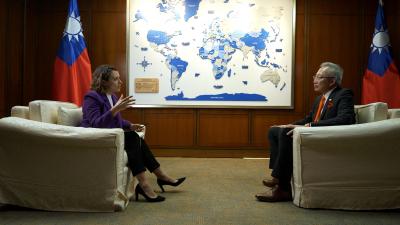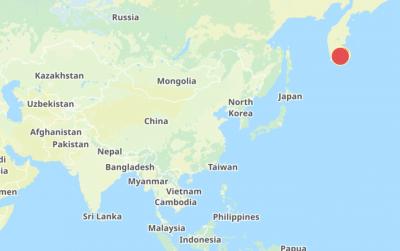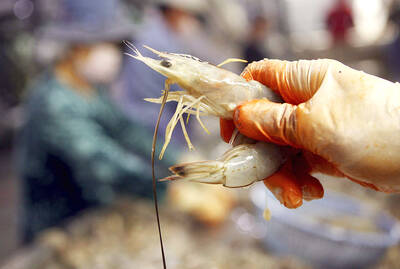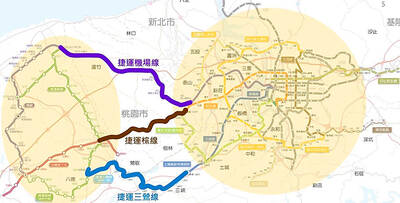The once pristine Siaoli River (霄裡溪), the source of drinking water for a small Hsinchu County town, has now become a battleground pitting local residents and environmentalists against two of the country’s most prominent manufacturers.
The dispute — a classic example of the tug-of-war between environmental protection and economic development — centers around the river’s growing pollution.
Sinpu Township (新埔) residents blame AU Optronics Corp (AUO) and Chunghwa Picture Tubes for the pollution, but the two high-tech companies deny any wrongdoing.
It may take months or even years to determine the source of the pollution, but residents are pleading for a quick solution to the degradation of their main water source, which was once one of the few rivers classified as having high water quality.
But in 2006, the Environmental Protection Bureau in Taoyuan County, where the Siaoli River originates, classified the stream as lightly polluted, and medium-polluted in certain seasons, although it did not find evidence of heavy metals.
ASSESSMENT
In an environmental impact assessment meeting last week, the two companies insisted that the wastewater they discharged into the river was not toxic, citing data showing that it conformed to environmental standards.
“But we believe that they hide some rare toxic elements that are not even part of environmental standards,” said Chen Jin-jin (陳金進), the head of an association of local residents that has followed the pollution issue for years.
At the meeting, the two companies proposed moving their discharge point from the Siaoli River to Taoyuan County’s Laochien River, which is already classified as “seriously polluted.”
The environmental panel, which held a meeting to decide on the proposal, failed to reach a decision and said the case would be reviewed in three months, leaving the issue unresolved for Sinpu residents.
Even if the wastewater is diverted elsewhere, however, it is hard to believe the Siaoli River will regain its past glory.
Adults recall when it was once a playground for the town’s children and served as a place to fish and wash clothes.
The river’s name may mean “river among the clouds, “but now it is simply a lonely river, without fish or children,” said Wu Jia-hsun, a retired school principal and Sinpu native.
“When I was little, I used to put a crab-pot in the ditch nearby. The next morning we could always find about one or two dozen crabs in it,” Wu said.
“But now, after the pollution, it’s difficult to find crabs,” he said.
Of greater concern to the town’s 36,000 residents, the river has also been an important source of drinking water because most households do not have access to tapwater.
Many are now forced to stock up on ground water from nearby mountains if they want natural drinking water.
Environmentalists believe the Chunghwa Picture Tubes and AUO factories built in 1999 near the head of the river are responsible for damaging the river.
Local residents say the plants, which each discharge about 20,000 tonnes of wastewater into the river a day, are impacting the health of people living alongside the river and damaging nearby rice fields.
“Thanks to the two factories, our Siaoli River has no more dry seasons,” said Chen, adding that the problem would not have arisen if original environmental guidelines had been followed.
APPROVAL
The Environmental Impact Assessment that gave conditional approval to the construction of the two factories stipulated that they would discharge their wastewater into a river more than 10km away, to prevent the Siaoli from being polluted.
“But the factories changed their drainage points to reduce costs,” Chen said.
Although the water emitted by the factories appears clear, fish disappeared from the Siaoli several years ago and the river now has an unpleasant chemical odor, he said.
At last week’s review meeting, representatives of the two companies reiterated that the tests on their wastewater discharge conformed to environmental standards.
But both were evasive, however, in describing the chemicals used during their manufacturing processes.
An owner of a downstream fish farm is convinced the companies are hiding something. He said about NT$30 million (US$987,000) worth of fish he was raising died overnight a few years ago, allegedly from pollution discharged by one of the plants, and he sued for damages in 2006.
The case is ongoing.
Humans may also be affected by the alleged pollution, as about 500 hectares of rice fields are irrigated with riverwater.
Chen said mercury has already been identified in at least one paddy in Sinpu, once known as “the granary of Hsinchu.”
There are also fears that the high electric conductivity in the water may lead to soil salinization.
The Taiwan Water Corp has tried to remedy the situation by pumping water from the Fongshan River, which feeds the Siaoli.
SKEPTICAL
But because the pumping station is located at the convergence of the two rivers — and is only separated from the Siaoli by a 1m high bank of soil and stones — residents remain skeptical about the quality of the water.
To fight for clean water rights, Chen and some college students have tried to convince the factories to move their drainage points, and plan to sue both the polluters and government agencies they suspect of malfeasance.
“We are only asking for clean, drinkable water and justice,” Chen said.

“China is preparing to invade Taiwan,” Deputy Minister of Foreign Affairs Francois Wu (吳志中) said in an exclusive interview with British media channel Sky News for a special report titled, “Is Taiwan ready for a Chinese invasion?” the Ministry of Foreign Affairs said today in a statement. The 25-minute-long special report by Helen Ann-Smith released yesterday saw Sky News travel to Penghu, Taoyuan and Taipei to discuss the possibility of a Chinese invasion and how Taiwan is preparing for an attack. The film observed emergency response drills, interviewed baseball fans at the Taipei Dome on their views of US President

The Central Weather Administration (CWA) today issued a "tsunami watch" alert after a magnitude 8.7 earthquake struck off the Kamchatka Peninsula in northeastern Russia earlier in the morning. The quake struck off the east coast of the Kamchatka Peninsula at 7:25am (Taiwan time) at a depth of about 19km, the CWA said, citing figures from the Pacific Tsunami Warning Center. The CWA's Seismological Center said preliminary assessments indicate that a tsunami could reach Taiwan's coastal areas by 1:18pm today. The CWA urged residents along the coast to stay alert and take necessary precautions as waves as high as 1m could hit the southeastern

ECONOMIC BENEFITS: The imports from Belize would replace those from Honduras, whose shrimp exports have dropped 67 percent since cutting ties in 2023 Maintaining ties with Taiwan has economic benefits, Ministry of Foreign Affairs officials said yesterday, citing the approval of frozen whiteleg shrimp imports from Belize by the Food and Drug Administration (FDA) as an example. The FDA on Wednesday approved the tariff-free imports from Belize after the whiteleg shrimp passed the Systematic Inspection of Imported Food, which would continue to boost mutual trade, the ministry said. Taiwan’s annual consumption of whiteleg shrimps stands at 30,000 tonnes, far exceeding domestic production, the ministry said. Taiwan used to fill the gap by importing shrimps from Honduras, but purchases slumped after Tegucigalpa severed diplomatic ties with Taiwan

The Executive Yuan yesterday approved a southwestern extension of the Sanying MRT Line from New Taipei to Bade District (八德) in Taoyuan, with a goal of starting construction by late 2026. The 4.03-kilometer extension, featuring three new stations, will run from the current terminus at Yingtao Fude Station (LB12) in New Taipei City to Dannan Station (LB14), where it will connect with Taoyuan’s Green Line, New Taipei City Metro Corp said in a statement. This extension will follow the completion of core Sanying Line, a 14.29-kilometer medium-capacity system linking Tucheng (土城), Sansia (三峽)